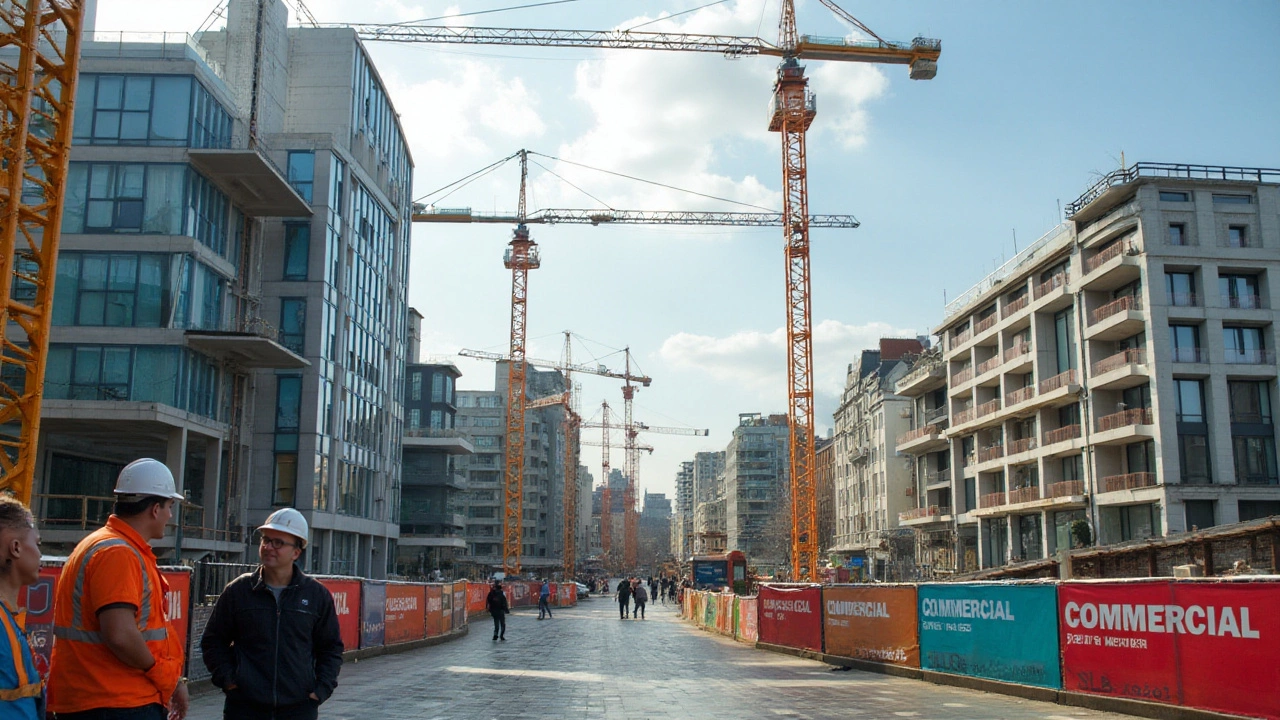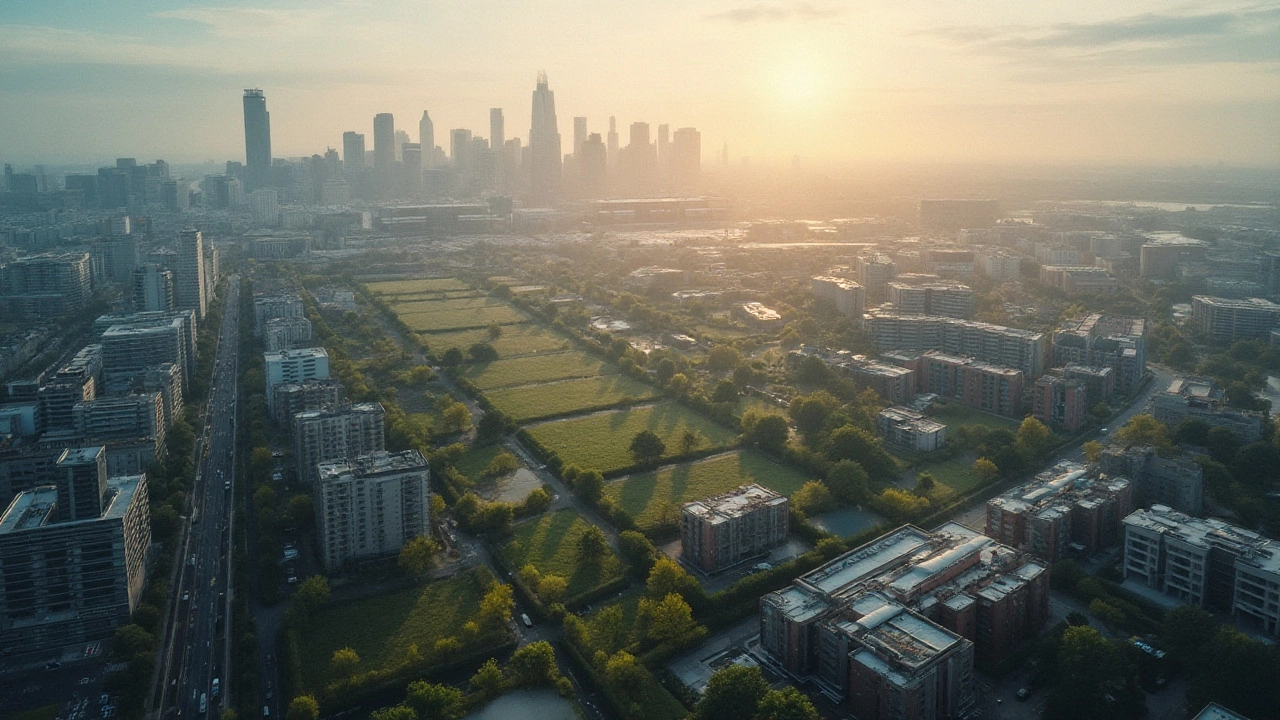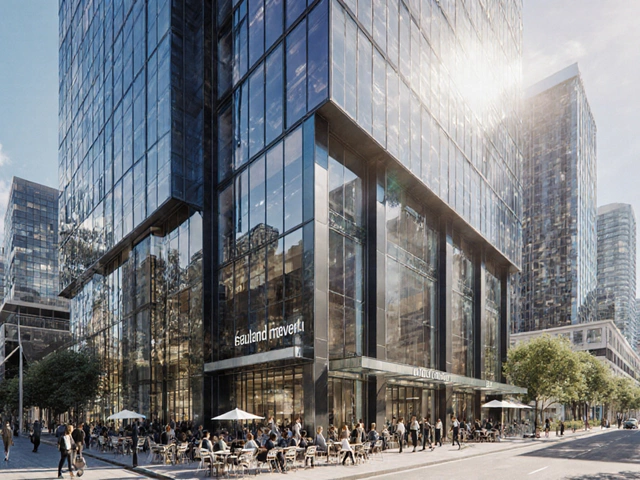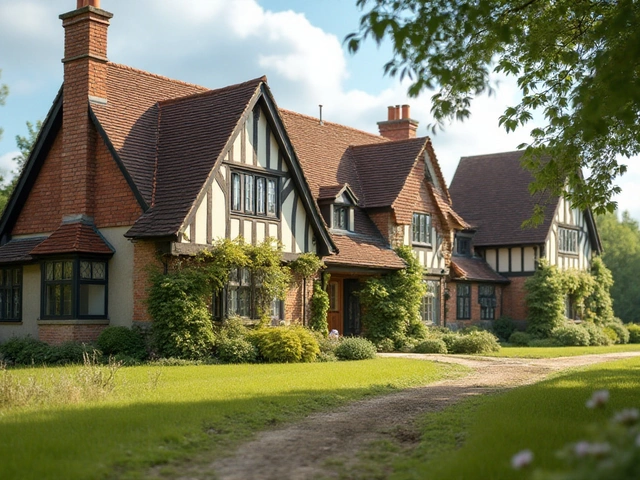
Diving into the world of construction reveals a universe where definitions help shape cities and skylines. Commercial use, a term frequently tossed around, carries significance in the building and planning sectors. Builders, developers, and city planners need to grasp what this term encapsulates, as it influences a multitude of factors from design to execution.
Commercial structures are not just about towering office blocks; they include a wide variety of buildings serving different purposes. As regulations evolve, understanding the permits and guidelines that govern these constructions can make or break a project. Additionally, the introduction of sustainable practices into commercial projects is becoming crucial, often dictating the longevity and success of a building. This piece will guide you through the intricacies of commercial use, revealing how these projects contribute to the surrounding community.
- Defining Commercial Use in Construction
- Types of Commercial Structures
- Regulatory Framework and Permits
- Impact of Zoning Laws
- Sustainability in Commercial Buildings
- Commercial Construction and Community Impact
Defining Commercial Use in Construction
When we talk about commercial construction, we’re diving into a specific facet of building activity that primarily focuses on creating spaces for business operations. This doesn’t just mean office skyscrapers that dominate city skylines; the term encompasses a variety of building types crafted for commerce, trade, and services. Think shopping malls bustling with weekend crowds, hotels offering the comforts of home to travelers, hospitals delivering essential care, and even multi-family housing complexes where the buzz of hundreds of lives intertwine daily. These diverse structures share a common thread—they’re designed and built for commercial purposes, intending to generate profit and serve a wide array of public needs.
The definition of commercial use can often be shaped by zoning laws and land-use regulations, which are established at municipal levels. These laws specify how parcels of land can be used, and categorize areas into types of use—be it residential, industrial, or commercial. The boundaries set by these laws are crucial because they determine not only where businesses can be located but also outline the types of activities that can happen within them. This regulation ensures that communities function smoothly, maintaining a balance between different sectors and minimizing conflicts that might arise from incompatible land uses.
According to Urban Land Institute, "Commercial properties cater to the needs of communities by providing goods and services, such as retail merchandise, office spaces, and medical care, contributing essentially to local economies and their growth."
To dive deeper, commercial use buildings also have distinctive requirements and construction standards compared to residential buildings. They must adhere to stringent safety regulations, energy codes, and accessibility standards across various levels of government. These buildings often contain specialized infrastructure to accommodate business activities, such as reinforced power supply systems, advanced HVAC units, and expansive telecommunications networks. For example, a hospital requires completely different structural considerations than a retail store, with specialized rooms, built-in medical gas supplies, and emergency pathways. It’s these tailored aspects that set commercial projects apart from other types of construction.
Additionally, the importance of commercial construction cannot be understated when reflecting on its economic impact. Not only does it provide essential services and goods to consumers, but it also creates employment opportunities, fuels local economies, and contributes significantly to urban growth. With every commercial project, a ripple effect ensues—benefitting suppliers, providing jobs to construction workers, and eventually opening doors for an array of service sector roles. In cities across the globe, these projects often act as pivotal points around which urban developments and trends gravitate.
| Type of Commercial Building | Purpose |
|---|---|
| Retail Stores | Selling goods directly to consumers |
| Office Buildings | Providing workspace for businesses and professionals |
| Healthcare Facilities | Delivering healthcare services and medical treatment |
| Hospitality Establishments | Offering lodging, food, and services to travelers |
In essence, understanding what falls under the umbrella of commercial use in construction involves recognizing both the structural characteristics and the broader societal roles these buildings fulfill. Whether it's contributing to economic vitality or laying the groundwork for technological advancement, each brick and beam is a testament to the essential role these structures play in our daily lives. With the ongoing evolution of commercial spaces influenced heavily by trends like remote working and digital commerce, the boundaries of what constitutes commercial use continue to grow and adapt to new societal dynamics.
Types of Commercial Structures
When you walk through a bustling downtown or a suburban development, the diverse commercial construction projects around you cater to a myriad of needs, shaping the very fabric of daily life. From towering office buildings to cozy neighborhood retail spots, these structures are categorized based on function and clientele. One common type is the office building, which ranges from imposing skyscrapers dominating city skylines to smaller business complexes. These spaces are tailored for a range of enterprises, providing not only location but also facilities that meet various professional requirements, including meeting rooms, open spaces, and tech infrastructure.
The retail sector sees another important category, which includes anything from the sprawling shopping malls to standalone stores. Modern retail structures often aim to create an experience beyond just shopping, incorporating entertainment zones, food courts, and recreational areas to attract more visitors. This trend highlights the growing importance of consumer experiences in commercial use. Consequently, the design and layout of these buildings emphasize accessibility, atmosphere, and customer flow, setting the stage for successful commercial operations.
According to the Urban Land Institute, "The mixed-use development model is increasingly popular in urban planning, blending multiple commercial activities to create a vibrant community hub."
Hospitality venues, such as hotels and resorts, serve different commercial purposes, focusing on aesthetics, comfort, and visitor satisfaction. These structures are meticulously designed to enhance the traveler’s experience, offering a wide range of amenities from luxurious suites to conference facilities. Moreover, restaurants and cafes, often part of hospitality services, require specialized construction approaches for efficient layouts in culinary and service areas, ensuring both safety and customer enjoyment.
Public and Government Buildings
Municipal and government buildings represent another significant category within commercial structures. These facilities, ranging from courthouses to post offices and libraries, must accommodate public service functions efficiently. Here, the emphasis lies on accessibility, security, and functionality, necessary for serving the broader community effectively. These structures often embody civic pride, showcasing meticulous architectural designs that also meet stringent regulatory standards, ensuring they can withstand high footfall and serve their intended purposes robustly.
In areas where technology firms thrive, tech parks and business incubators are steadily rising. These commercial constructions cater specifically to start-ups and established tech companies, offering adaptable office spaces, state-of-the-art facilities, and a collaborative environment that fosters innovation. Equipped with advanced connectivity and eco-friendly designs, these structures are a hallmark of modern commercial construction. As these diverse types underscore the dynamism of commercial architecture, they reflect the evolving needs and aspirations of society today.

Regulatory Framework and Permits
Diving into the commercial construction world, understanding the regulatory framework and permits processes is crucial. Each project must adhere to a myriad of regulations distinct to its nature and location. This framework exists to ensure that buildings are safe, meet design standards, and accommodate community needs. In the United States, for instance, projects must comply with both federal and local regulations, which can sometimes be complex to navigate. It requires a keen eye on the zoning laws, building codes, and permits essential to avoid legal complications and ensure smooth execution.
Permits are documents granting official approval to proceed with a construction project, critical in dictating what modifications are allowed. They cover various aspects from structural integrity to environmental compliance, making them integral in the commercial use landscape. Acquiring these permits often involves a series of procedures and documentation. Typically, the process begins with submitting plans to local authorities for review, which checks adherence to existing laws. This might include fire safety evaluations, disability access considerations, and sustainability assessments.
"A permit's role is to act as a community's safeguard; without it, the risks extend not only to the building's occupants but also to the wider environment," stated Jane Doe, a respected urban planner, highlighting the importance of permits.
Many developers find the regulatory maze challenging, especially when trying to balance innovation with compliance. However, this system is not merely bureaucratic red tape; it plays a pivotal role in maintaining harmony between new developments and existing community fabric. For example, in densely populated urban centers, these regulations help ensure that new structures contribute positively to the skyline without overwhelming local infrastructure.
The Importance of Zoning Laws
Zoning laws are an integral part of the regulatory framework impacting commercial construction. These laws dictate the types of buildings allowed in particular areas, affecting their height, density, and functional use. Understanding how zoning impacts a project is essential before ground-breaking. Zoning reviews may encompass evaluations related to traffic impact, public facilities compatibility, and even aspects like noise levels or waste management, all crucial for community welfare.
Statistics show that in 2022, nearly 30% of new commercial use projects faced delays due to zoning conflicts. This startling figure underlines the importance of thorough due diligence. Successful navigation often requires engaging with local planning committees, adapting proposals with flexibility, and foreseeing potential community resistance.
- Acquaint yourself with local building codes.
- Develop a comprehensive plan that aligns with safety and zoning regulations.
- Engage early with permit officials to anticipate challenges.
- Consider employing specialists for regulatory analysis and document preparation.
- Maintain transparency with local stakeholders to facilitate smoother approval processes.
Smart navigation of the regulatory jungle means not only securing your project's legality but also ensuring its long-term viability. Amidst these intricacies, commercial projects can flourish, contributing to both economic vigor and community enrichment.
Impact of Zoning Laws
Zoning laws have a profound impact on the commercial construction landscape, acting as a crucial framework within which developers operate. These laws essentially divide a municipality into sections, dictating the types of buildings that can be developed in each area, and establishing the rules for how those buildings should be constructed. This zoning system can determine whether a piece of land can be used for residential, commercial, industrial, or agricultural purposes, and often influences building heights, lot sizes, space allocation, and even aesthetic elements such as color schemes.
The origins of zoning laws trace back to early 20th century America, with New York City implementing the first comprehensive zoning ordinance in 1916. This historic move set a precedent as urbanization exploded, necessitating a system to manage the interplay between different land uses. Zoning laws, therefore, not only help maintain public order and safety by preventing potentially hazardous mixing of building types but also play an economic role by preserving property values. As cities continued to grow and evolve, so too did zoning frameworks, each often tailored to local needs and circumstances.
For developers engaged in commercial construction, zoning can be both a boon and a bane. On one hand, it ensures that commercial buildings are erected in areas with appropriate infrastructure and minimal conflict with nearby residential areas, leading to increased foot traffic and business potential. On the other hand, zoning restrictions might limit a company’s ability to expand or innovate, particularly in tight urban settings where space is a premium commodity. A particularly interesting aspect is the introduction of mixed-use zoning in many urban centers, which allows residential, commercial, and sometimes industrial uses to coexist in a single area. This flexibility encourages vibrant, integrated communities but requires careful planning to succeed.
According to Jane Jacobs, an urban planning doyenne, "Cities have the capability of providing something for everybody, only because, and only when, they are created by everybody."
To navigate the complexities of zoning laws, it is imperative to have a solid understanding of the specific requirements in the locality of interest. This often involves consulting local zoning maps and codes, engaging with city planners, and sometimes attending public zoning meetings, where one can advocate for rezoning or variances. Such meetings are important venues where community members and prospective developers can express concerns or petition changes that might affect both the individual project and the greater environmental context. Legal counsel specializing in zoning is also an invaluable resource to negotiate the intricate layers of regulation.
Another critical facet relates to sustainability. Recent shifts in urban development priorities have seen zoning laws increasingly incorporate green building practices and sustainability standards, recognizing the importance of energy-efficient, environmentally-responsible construction. There’s a growing trend towards eco-districts and promoting commercial buildings that leverage green technologies, which impacts zoning decisions significantly. The move towards sustainability is not only a regulatory shift but also a market-driven demand; tenants and consumers are more inclined to support businesses with visibly green credentials.
The ramifications of zoning laws extend beyond regulation and impact a community's fabric, shaping everything from traffic patterns to the economic vitality of a neighborhood. As such, successful commercial construction relies not just on adhering to these codes but also on understanding and contributing to the community’s larger ecosystem. Investing in research and development of infrastructure, maintaining dialogue with local authorities, and aligning with community goals are all important steps in mastering these laws while furthering business objectives. As urban landscapes continue to develop, staying informed about zoning trends and participating proactively in planning discourse remain essential strategies for any stakeholder in the field.

Sustainability in Commercial Buildings
In our modern age of architecture and design, the push towards more sustainable practices in commercial construction projects can't be overlooked. As cities grow, the structures within them multiply and evolve, transforming urban landscapes worldwide. Yet, with this growth, there's a pressing responsibility to ensure that these structures are not only efficient but also environmentally friendly. Key elements like energy efficiency, resource management, and reduced environmental impact take center-stage when planning these edifices. From the selection of materials to the optimization of energy use, integrating sustainability into commercial buildings has become not just a trend, but a necessity.
One of the primary aspects of sustainability in commercial buildings is energy efficiency. Buildings are significant energy consumers, accounting for roughly 40% of global energy usage and a similar percentage of CO2 emissions according to the International Energy Agency. Therefore, reducing energy consumption through design innovation becomes paramount. Techniques such as installing advanced HVAC systems, using natural lighting, and implementing smart building technologies can drastically cut down energy use. The adoption of these measures contributes not only to reducing expenditure on energy bills but also significantly lowers the carbon footprint of these structures, helping in the fight against climate change.
"Incorporating sustainability into building design is the first step towards creating eco-friendly communities," says Emily Ramshaw, a noted environmental architect prominently working with commercial buildings.
Another critical component to consider is the selection of sustainable building materials. Emphasizing recycled, renewable, and locally sourced materials can drastically cut down on the environmental impact of construction projects. Materials like reclaimed wood, bamboo, and recycled steel are just a few examples of sustainable options that can be used. The environmental benefits are compounded when these materials reduce energy use during production and transportation, as well as when they offer superior thermal properties, enhancing insulation and reducing heating and cooling needs.
Water conservation is an often underappreciated aspect of sustainable building. By incorporating modern plumbing fixtures and water-efficient landscaping, commercial structures can achieve significant water savings. Technologies such as rainwater harvesting and greywater recycling systems can be integrated seamlessly into the building's infrastructure to support these efforts. This conservation is vital, especially in urban areas facing water scarcity challenges. These practices not only contribute to a building's sustainability credentials but can also lead to cost savings in utility bills over the long term.
Looking at the long-term benefits, sustainable commercial buildings often lead to higher property values and stronger corporate images. Beyond cost savings, these buildings tend to attract environmentally conscious tenants and employees, adding to their marketability and value proposition. The choice to invest in sustainably designed commercial spaces reflects a commitment to corporate social responsibility, positioning businesses as leaders in the growing green economy.
Technological Innovations and Sustainability Certifications
Technological advancements are driving the possibilities for sustainability in commercial buildings. From smart grids to predictive maintenance of building systems, technology is helping buildings operate at peak efficiency. Green Building certifications such as LEED (Leadership in Energy and Environmental Design) and BREEAM (Building Research Establishment Environmental Assessment Method) provide frameworks for measuring a building's environmental impact and guide developers in implementing feasible sustainable solutions.
In exploring sustainability, it's vital to not only consider immediate benefits but also the lasting impacts on communities and environments. As businesses and residents alike continue to prioritize environmental considerations, the role of sustainable practices in the construction of commercial structures will only increase. This shift requires a commitment to continuous improvement, always searching for new ways to innovate and improve.
Commercial Construction and Community Impact
Commercial construction significantly shapes the landscapes of our communities, influencing everything from economic growth to the daily lives of the residents. When a new commercial development, be it a shopping mall or a corporate office, emerges in a neighborhood, it often brings with it a surge of job opportunities. These jobs range from construction roles during the building phase to long-term positions in retail or management once the project is completed. The presence of new businesses can spark local economic revitalization, especially in areas previously lacking commercial infrastructure. This influx of prosperity not only elevates the economic status of a community but may also improve public amenities through increased tax revenues.
The impact of commercial construction extends beyond economics. As new structures rise, there is often a revitalization of the surroundings, which can enhance the visual appeal and functionality of a neighborhood. Green spaces may be introduced as part of sustainable development initiatives, as many new projects incorporate eco-friendly design principles. According to a study conducted by the National Association of Home Builders, "commercial constructions account for over 13 percent of the nation's GDP, highlighting its pervasive influence." However, this growth needs to be managed carefully to balance the benefits with potential drawbacks, such as congestion and the strain on existing infrastructure.
Community response to commercial development can vary widely. While some residents may appreciate the convenience of having more services nearby, others might raise concerns over increased traffic and changes to the community fabric. Effective communication and engagement with local residents are thus crucial. Developers often hold public forums and meetings to present plans and gather feedback. This collaboration can lead to adjustments that mitigate potential negative impacts, such as integrating better traffic control measures or enhancing local amenities. By fostering a transparent development process, trust is built, paving the way for developments that are both successful and warmly welcomed.
Sometimes, the transformative power of commercial structures can inadvertently lead to a phenomenon called gentrification, where rising property values and living costs push out long-time residents. While it speaks to the success of a new development in attracting wealth and investment, it requires careful planning and policy-making to ensure that the benefits of commercial projects are equitably distributed across all community members. Many cities now implement affordable housing quotas within commercial zones to combat such displacement. A balanced approach helps uphold a vibrant, diverse community, preserving the unique cultural tapestry of the area.
The sustainability of commercial buildings is becoming an important consideration in modern construction. Sustainable buildings not only reduce environmental impact through energy efficiency and waste reduction, but they also enhance community appeal. Features such as rooftop gardens, rainwater harvesting systems, and solar panels are increasingly common. They serve not just as functional aspects but also as educational tools for public awareness. As communities become more environmentally conscious, commercial buildings designed with sustainability in mind contribute to this growing movement, making them vital players in the broader pursuit of a greener future.
Commercial construction, with its multifaceted impacts, holds the potential to redefine community life. As we move into an era where urban areas are rapidly expanding, sensitive, and inclusive planning becomes imperative. By respecting the history and needs of neighborhoods while harnessing the economic and infrastructural benefits these projects offer, commercial constructions can genuinely serve as a catalyst for positive, lasting change. It is through this careful balance that communities can thrive and sustain under the evolving landscape of modern development.




